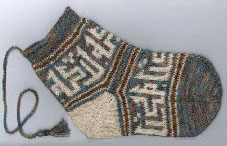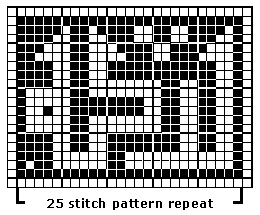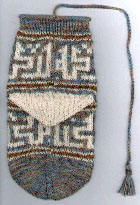Dar Urtatim: Medieval Egyptian Knitting 3Medieval Muslim Egyptian-Style Knit Ankle Sock |
Here is a pair of socks i made in my experiment to learn authentic Medieval Egyptian knitting techniques. SuppliesTools
Yarns
|

ToeIt took a very long time for me to figure out how to cast on the toe. After many false starts, I formed a circle with the blue yarn, leaving a longish tail. Then with a crochet hook, I made a slip stitch over the loop and one single crochet into the slip stitch, then transferred the loop to a needle. I repeated this 4 times, for a base of 4 stitches. Many scholars of knitting think that the Medieval Egyptian knitters used needles such as were common in Eastern Europe in the 19th and early 20th centuries (and still are), that is, pointed at one end and hooked at the other. Thus my method of casting on could be worked with such needles. There are no objects from Medieval Egypt identified as knitting needles, so at this time we don't really know if they used such needles. Then I had to figure out how I wanted to increase from 4 stitches to 72. First I tried yarn-overs. After knitting about 20 rounds I decided that, while the lacey holes may look nice, they would be inappropriate in the toe of a sock. So I ripped out the 20 rounds and tried again. The method I used to add stitches was ok, inserting the needle in the strand between two stitches of the rounds I'm knitting into (now I know how to increase by knitting one into the front of the stitch on the needle and one into the back of the stitch on the needle). But I increased every round - this was too fast and the toe shape wasn't working. So, I ripped out the 15 or so rounds, and started again. This time, I increased every other round, which worked pretty well. I think that next time, as I get near the end of the toe, I need to increase every third round or so, rather than every second round, but the way I did it is functional. I ended up doing (a round with increases and knitting a round without increases) eight times, so the first part of the toe is 16 rounds.
Then I knit the toe on 72 stitches for 8 more rounds. |
FootNext I knit a round of white, two rounds of heather brown sport yarn which I broke off when I was done, and a round of white. The rest of the foot is made up of a pattern of Kufic Arabic script that says "baraka," which means "blessing." The pattern, which covers 18 rounds (including a beginning round of blue and and ending round of blue), is a repeat of 25 stitches, which I realized as I started knitting the two rounds of blue, just before starting the first round of white pattern. Because I was working on a base of 72, I increased 1 stitch per needle on three needles to get from 72 to 75 stitches total. [See pattern chart at right] The pattern is a bit tricky. At first glance it appears that every round is repeated twice, but a closer look shows that this is not quite true, so the knitter needs to keep alert. I made a few errors. First, I did knit every round twice until I got near the top of the pattern. I also realized when I was nearly done that I had knit the pattern mirror image, since as a lefty I knit from left to right, but had followed the pattern as a righty does from right to left. Arrrgh! But I wasn't about to rip out 16 rounds of knitting.
|
NOTE: White squares around pattern are only to help you count rows and stitches
|

Heel PreparationThen I began to work the heel. First, I put needles 2 and 3 on hold. Using needles 1 and 4 as working needles, I knit in some waste yarn beginning on needle 4 and continuing onto needle 1; then I knit back across from needle 1 to needle 4. LegThen I knit around the leg with blue yarn for two rounds, beginning on needle 1. Then I knit 1 round of white, 2 rounds of brown which I broke off when I was done with it, and 2 rounds of blue. At that point I was impatient to get the heel done, so I left the 4 needles in place in the leg, and used 4 more number 2 needles for the heel (yeah, I've got one set of 4 and one set of 5 number 2 needles). I also broke off all the yarns at this point so they wouldn't be in the way. Inset HeelAs I pulled out the waste yarn, I evenly distributed the stitches on 4 needles (well, as evenly as possible since I had 75 stitches - that meant 3 needles of 19 and one of 18). Then with the white yarn and starting with the equivalent of needle 4, I knit a round of white in every stitch. Beginning on needle 4, I knit one, decreased one, knit across, continued knitting across needle 1 until 3 stitches from the end, then I decreased one, and knit one; continuing on needle 2, I knit one, decreased one, knit across, continued knitting across needle 3 until 3 stitches from the end, then I decreased one, and knit one. That ends the first round of the heel. I continued this way, decreasing 4 on every round until I had only 7 stitches left. Then I took the stitches off the needle, lined them up so the side with 3 stitches interlocked with the side with 4. I cut off the white leaving a longish tail. I threaded the tail onto a round-tipped tapestry needle and threaded the thread with the white, then I ran the yarn through the interlocked stitches, then turning the sock wrong side out, and bringing the needle from the right side to the wrong side, I pulled the yarn a little tight, but not too much, and wove the end into the heel. Next time I do this kind of heel, I will graft the final stitches, instead.
I chose to use the white yarn, rather than the blue for two reasons. One, several of the extant socks have white heels. Second, this cotton-wool blend is heavier than the wool-nylon blend. I just hope it holds up under wear. Well, time will tell... |
|
Finishing the LegI had already knit a round of the pattern, a round of solid blue. So I began the pattern with the white yarn. This time I was careful to read the pattern the left-handed knitter way, and knit the Kufic script so it was facing the correct way. I also was careful to watch out for the odd single rows in the pattern. So on the leg the "baraka" is readable - see front of sock where it is centered and complete. I tried on the sock at this point. The 75 stitches made the sock leg a bit wide, so I began decreasing stitches in the final blue rows. Although I made the same number of decreases per needle, I put the decreases somewhat randomly around in each row so that there wouldn't be a noticeable pattern of decreases. I knit a round of white, two rounds of brown which I broke off when I was done with it, and a round of white which I broke off when I was done with it, decreasing in every round as necessary, and trying on the sock after every round to make sure I decreased enough. I ended up with 49 stitches around - this is still loose around my ankle, but I need around this many to get the sock over my heel. If your leg is longer than mine, you may need to continue adding decreases in the blue rounds that follow. Then I knit around in blue until the sock was comfortably high. In my case I knit 9 rounds of blue. If your leg is longer than mine, you may need to knit more rounds of blue or even add another band of white-brown-white. Then I cast off. To make sure this would be stretchy enough, I used a number 5 double pointed needle to take the stitches off the number 2 needles. And I worked the last stitch into the first stitch of the round. Then with a crochet hook of the appropriate size, in this case an F, I crocheted a chain long enough to go around my leg 1 and 1/2 times. I broke off the yarn and left a long tail. Then with the blue yarn I made a tassel which I attached to the end of the chain. Then I made the second sock, with both bands of Kufic script done correctly... Wearing the SocksI wore the socks around the house. They were a bit baggy on my size 4-1/2 narrow feet, but they were really nice and warm and toasty on my chilly tootsies. And after wearing them for a few evenings, it was time to wash them. I put them in with other clothes, washed on cold and dried on cool. They came out fine. |
|
On to Pouch and Mittens. Back to the Knitting Room in Dar Urtatim. Back to al-Riyad, the Courtyard at Dar Urtatim, for other Textile and Garb stuff. Questions? Comments? Suggestions?
You can write to me here. |

